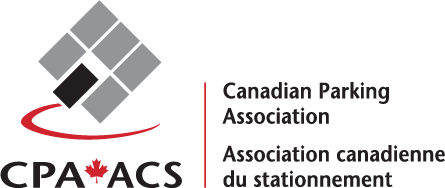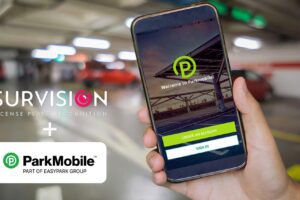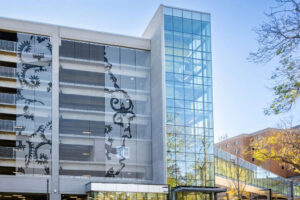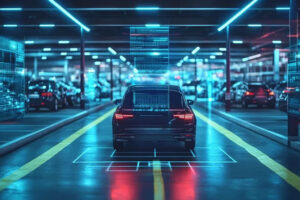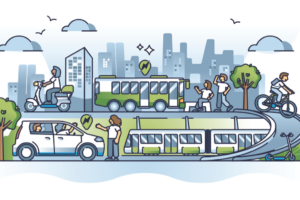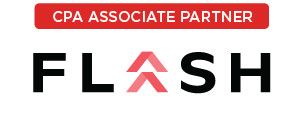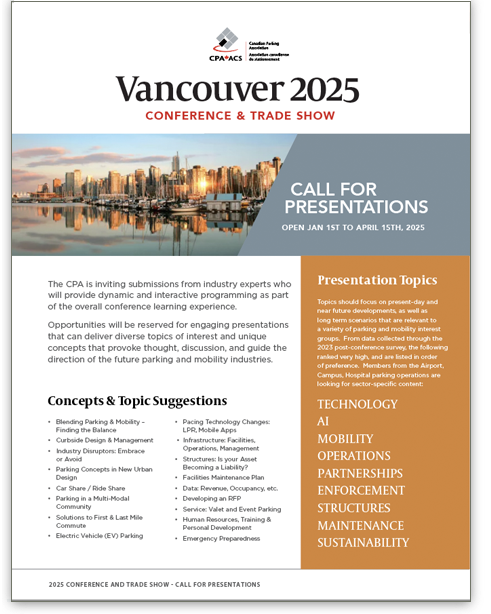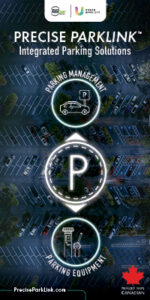By Steve Gorski
The Canadian government strongly supports the development of smart cities as a means to enhance urban sustainability, digital innovation, and public well-being. Initiatives like the Smart Cities Challenge launched by Infrastructure Canada and the Investing in Canada Plan have led to the investment of hundreds of billions of dollars in smart city development across Canada. And these investments have been perfectly timed. The introduction of innovative parking and mobility technologies in recent years is making it possible for the longstanding smart city dreams of federal, provincial, and municipal leaders and urban planners to finally be realized.
At the core of smart city initiatives are several key objectives aimed at improving the quality of life for citizens: reduced congestion and enhanced mobility, better energy management, more resilient and adaptive infrastructure, more efficient public services, and greater citizen engagement.
The Role of Technology in Smart Cities
Technology is the key enabler of smart city development, facilitating real-time data collection, processing, and analysis to drive efficient urban system management. The most important smart city technologies include:
- Parking Guidance Systems (PGS): Directs drivers to available parking spaces, reducing congestion and emissions caused by unnecessary searching.
- Parking and Revenue Control Systems (PARCS): Automates parking management, integrating payment, access control, and occupancy tracking.
- Intelligent Traffic Systems (ITS): Utilizes real-time data and algorithms to optimize traffic flow, enhance safety, and reduce travel times.
- Parking Pre-Booking: Allows drivers to reserve parking spaces in advance, streamlining city logistics and improving the user experience.
- AI for Predictive Wayfinding: Combines AI with real-time data to guide drivers to optimal routes and parking spots, reducing delays, and enhancing urban mobility.
Hardware is just part of the equation though. To create seamless smart cities, open interfaces and interoperability are crucial. First…
By Rick Neubauer
Curb management is rapidly becoming a major issue in Canada, particularly in densely populated cities like Toronto, Vancouver, and Montreal. Urban congestion is increasing for a number of reasons, including rising e-commerce deliveries, the growing presence of ride-hailing services, and the overall demand for curb space. This has created a pressing need for municipalities to rethink how they allocate and regulate curb space effectively.
Why is it so important for cities throughout Canada to address this issue? Rising competition for curb space has led to increased traffic congestion and related safety issues, a host of regulatory challenges as cities struggle to create curb management policies from scratch, and stumbles in achieving sustainability goals. Without well-planned curb management strategies, cities risk worsening congestion, facing increased carbon emissions, and suffering from inefficient use of public space.
The good news is that technology can help. As municipalities strive to develop smart city initiatives, artificial intelligence (AI) has emerged as a promising tool to enhance curb space efficiency as well as anticipate and meet evolving urban mobility demands. However, the rise of “AI-washing” has made it difficult for cities to differentiate between truly valuable AI-powered solutions and mere marketing buzzwords.
Identifying True AI-Powered Solutions
While AI has the potential to revolutionize curb management by leveraging predictive analytics and allowing cities to take a more proactive stance on managing curb real estate, not every technology that claims to use AI is genuinely leveraging its capabilities. Many companies in the parking and mobility sector promote their solutions as AI-driven when they are merely repackaging basic data analytics or rule-based automation. This phenomenon, known as AI-washing, makes it harder for decision-makers to identify which technologies offer real, strategic value. To avoid succumbing to AI-washing, city planners and managers should ask key…
Miami FL (March 12, 2025) – Survision, a global leader in Vehicle Identification technology, has successfully integrated its advanced Cloud Parking Enforcement Software, PlatEnforce, with Parkmobile, a leading mobile parking payment platform. This strategic software integration enables parking operators to seamlessly enforce paid parking policies at sites using Parkmobile, improving efficiency and compliance.
With this integration, parking operators leveraging Parkmobile’s system can now automatically validate payments and enforce parking violations in real time using Survision’s PlatEnforce. This reduces the reliance on manual enforcement and enhances accuracy, ensuring a streamlined parking experience for both operators and customers.
Key Benefits of the Integration:
- New Flexibility for Operators: Survision Solution can be easily moved from one vehicle to another
- Automated Parking Enforcement: PlatEnforce seamlessly cross-references Parkmobile transactions, identifying violations instantly.
- Enhanced Accuracy and Efficiency: Eliminates human errors associated with manual enforcement methods.
- Cloud-Based Solution: Offers remote access and real-time enforcement data, improving operational flexibility.
- Seamless User Experience: Ensures a frictionless process for customers, with fewer disputes and increased compliance.
“I have always admired ParkMobile’s mission to make cities more livable, and I am thrilled that Survision’s vehicle identification technology can play a key role in enhancing this vision. By integrating our advanced solutions, we can provide a seamless parking experience for users while helping operators improve efficiency and compliance. This partnership is another step toward creating smarter, more enjoyable urban environments for everyone.” Laura Caillot, Managing Director at Survision LLC
The integration is now live and available to parking operators utilizing Parkmobile’s payment system, allowing them to enhance enforcement strategies and maximize revenue while ensuring fair parking compliance.
For more information on how this integration can benefit your parking operation, visit survisiongroup.com/platenforce and https://parkmobile.io/.
By Stephanie Nowe-Morris
Parking structures are often overlooked in urban planning, especially in healthcare settings where demands are unique and multifaceted. The recently opened QEII Health Sciences Centre Parkade stands as a testament to Nova Scotia’s commitment to accessible and sustainable design, providing a new model for modern parking that balances functionality with community needs. This editorial explores how the QEII Parkade has transformed into a vibrant landmark, integrated part of Halifax, serving patients, visitors, staff, and the broader community.
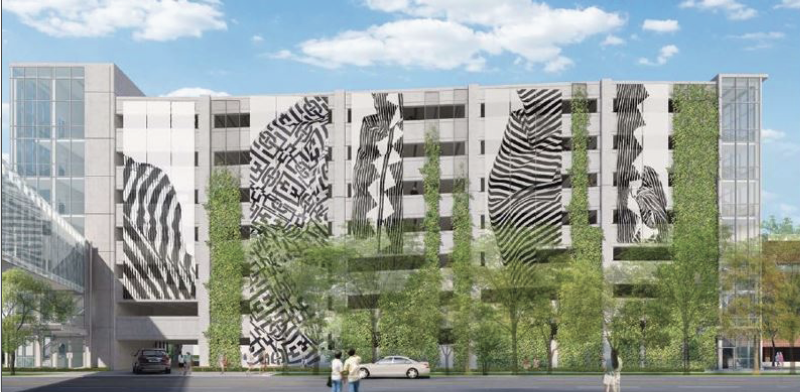
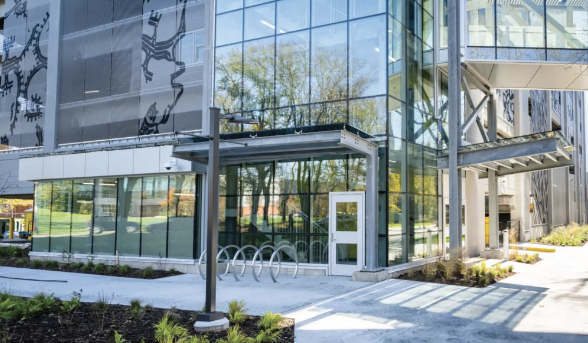
1. Designing for Accessibility in Healthcare
Accessibility lies at the heart of the QEII Parkade’s design. Located directly across the street from the Halifax Infirmary, accessible by a pedway the parkade provides convenient, centralized parking for patients, visitors, and healthcare staff, with a capacity for 540 vehicles. This proximity minimizes walking distances, offering seamless access for those with limited mobility and reducing stress for anyone navigating healthcare services.
To ensure universal accessibility, the parkade includes a range of thoughtful features. Ample accessible parking spaces, intuitive wayfinding signs, and resting areas have all been incorporated to prioritize comfort. A pedway connection from the parkade to the main lobby enhances safety and ease of access, and redundant elevators, tactile indicators for the visually impaired, and Staxi services further emphasize inclusivity. The QEII Parkade sets a new benchmark in accessible design for healthcare infrastructure, highlighting the importance of creating spaces that support all individuals’ needs.
2. Public Consultation: Engaging Stakeholders for Better Community Integration
Community integration was a key priority throughout the planning and design process of the QEII Parkade. Extensive public consultations took place to engage local stakeholders and address any concerns, ensuring that the parkade would be welcomed by the Halifax community. This…
By Todd Tucker
The Smart City. It has been the goal of urban planners and municipal leaders for years. When planners and politicians picture a smart city, they see an urban environment where technology and data collection improve the quality of life and the sustainability and efficiency of city operations.
For many communities, the most important manifestations of smart city planning revolve around mobility and parking. If visitors to an urban center can get to their ultimate downtown destination quickly, directly, and safely, the benefits are significant. Roads become less congested and, as a result, safer; the quality of life improves because of this reduced congestion; and local businesses are more likely to thrive because it’s easier for patrons and employees of local businesses to get downtown.
Smart city success is built on technology, and parking technology is the key. Specifically, parking guidance technology. Drivers need to park and making it easier to park will dramatically reduce congestion on city streets. There are several apps serving Canada that can provide basic information about where parking is available in a given city and how much it costs. But most are missing an essential element: occupancy data. These apps aren’t as useful as they could be if they don’t tell users whether there’s parking available in the parkade they’re choosing.
That’s why parking guidance technology is the driving force behind smart city parking planning. The technology already exists, and it’s up to Canada’s cities to implement those technologies.
The Power of Data
Smart cities run on data—data about where parking is available at that moment. The technology to produce the data is available, but so far, most cities and private parking owners haven’t taken full advantage of it.
Parking guidance technology makes it easy to…
Electric Vehicle Performance in Extreme Winter Conditions
By Wayne Sum and Bill Franklin
Introduction
Few denizens of Canadian cities give thought to the sophisticated and robust civic infrastructure and organization that enables a safe and enjoyable life whether uptown, downtown or in suburbia. Clean, well lit, well built and maintained streets, effective policing, parking, garbage collection, water and sewage, libraries, parades, medical centers among a multitude of other services all directly impact the satisfaction and safety of city residents.
Management of a dynamic and resilient city will consider key factors that can be employed in an emergency, whether it be political protests, rampant homelessness to fires, flooding or intense cold and blinding snow.
As the fires in California vividly attest, global warming and drought has intensified the desire to reduce reliance on internal combustion engines in favour of electric vehicles that get their energy for locomotion directly from the sun, wind or water (hydroelectric). In this article, we look at the challenges of achieving an all-electric fleet while retaining the resilience required from municipal services.

Massive fires in Ventura county California, seen by author driving on Highway 101 from LA to Santa Barbara on November 6, 2024.
Consideration of EV’s touch on the following topics:
- Saskatoon’s Electric Vehicle goals
- Electric Vehicle (EV) performance in general
- A closer look: Nissan Leaf
- Winter Driving Conditions and impact on EV driving range
- Theoretical look at
- Impact of cold on battery performance
- Impact of cold on power consumption
- Real World Tests: Consumer Reports, American Automobile Association
- City of Saskatoon’s pilot EV experience
- Recommendations to advance electrical vehicle utilization
The road to reducing Saskatoon’s carbon footprint starts here…

By Nigel Bullers, Shirley Rodriguez, and Paul Yakutchik
In a bustling city like Vancouver, where urban density and mobility challenges are constantly on the rise, creating a seamless parking experience is critical. EasyPark Vancouver, in collaboration with technology partners Fennix Systems and ZipBy, has taken a bold step toward revolutionizing the parking landscape. This summer, a groundbreaking technology pilot was launched at two of Vancouver’s busiest parking locations—Lot 19 and Lot 126/31—ushering in a new era of frictionless parking.
The initiative aims to enhance safety, efficiency, and sustainability while making parking as effortless as driving on a toll highway. The results are in, and the innovative solution is already making waves in the industry, setting a benchmark for what parking can—and should—look like in the future.
A Vision for Seamless Parking
At its core, this project addresses a simple yet vital need: the demand for a faster, easier, and more secure parking experience. Traditional parking systems, with their reliance on ticket dispensers and manual payment methods, often create bottlenecks and customer frustration. EasyPark recognized that a transformative solution was needed to eliminate these barriers.
In partnership with Fennix and ZipBy, EasyPark deployed cutting-edge technologies designed to streamline every step of the parking process. The solution integrates Fennix’s AI-powered license plate recognition (LPR) cameras with ZipBy’s innovative mobile app, providing drivers with touchless entry, automated payment, and seamless exits. The system is designed to provide a “drive-through” experience, allowing customers to enter, park, and leave without ever interacting with a meter or gate.
This transformative approach relies on dual optical and infrared LPR cameras with an impressive 99% accuracy rate. These cameras identify vehicles in real-time, enabling the system to open gates automatically. Meanwhile, ZipBy’s app leverages Bluetooth and GPS to track parking sessions, notify drivers when…
By Ebby Zachariah and Chris Perry
Over the past 20 years mixed-use development has become a staple of urban development in Canadian cities. It’s easy to see its appeal for developers and property owners. By combining several different use cases within a single development, developers and owners can benefit from a variety of potential revenue sources. And the diversity of uses can provide stability because when one sector slows down there will be one or more other uses remaining to pick up the slack.
Typically, owners and developers—and urban planners, for that matter—view mixed use solely in the traditional context of a development combining parking, and then some mix of retail, commercial, residential, and/or entertainment development. But there’s another form of mixed-use development that’s worth considering: parking. Yes, just parking.
As parking professionals, we instinctively understand how a development that revolves solely around parking can be an example of mixed-use. Most parking facilities serve multiple user groups. These groups have different needs, use parking assets differently, and may pay different rates. This is true of commercial, residential, and even institutional development with parking assets.
When parking owners start to think about their parking assets in this context, it opens up a whole new world of revenue and tenant amenity opportunities.
A Whole New Ballgame: Parking Management Technology
Until recently, it wasn’t possible to manage parking assets effectively and efficiently when there were multiple use cases. Parking had to be treated as an afterthought at best—and a throw-in at worst—because parking management wasn’t automated. It was just too costly and time-consuming to manage different parking use cases by hand.
With the emergence of parking management software platforms, however, owners can now manage each user group differently, providing access to specific areas of a parking facility, offering access at…
By Adamo Donatucci
In the parking and mobility industry, technology is pivotal in shaping its future. Across the globe, certain nations are at the forefront, strategically embracing advancements such as autonomous vehicles, micromobility solutions, intermodal applications, and shared zero-emission initiatives.
Below is a comprehensive exploration of various country policies, exploring the complex process of technological adaptation and their concerted efforts toward achieving ambitious zero-emission goals.
1. Autonomous Vehicles — A prominent force at the forefront of the automotive industry.
Undoubtedly, autonomous vehicles (AVs) have become a focal point in the mobility industry in recent years. According to a recent study by the global management consulting firm McKinsey & Company, passenger car advanced driver-assistance systems and autonomous-driving (AD) systems could generate $300 to $400 billion in revenue by 2035. Level 4 high-driving automation is anticipated to contribute $170 to $230 billion, accounting for approximately 57% of the dominant vehicle type in sales. Overall, the expectation is that 12% of new passenger cars sold by 2035 will incorporate Level 3 and 4 autonomous technologies, with 37% featuring advanced AD technologies.
For years, global car manufacturers, particularly in the United States and Europe, have promised a future of self-driving vehicles. However, recent trends suggest China is poised to lead the global shared AVs market. Research indicates that the top 5 regions in China collectively command 51.3% of the total autonomous mobility market. At the same time, the United States holds 47.5%, and Europe (including the United Kingdom, France, Spain, and Germany) accounts for 62.3%.
Government support is a crucial factor in fostering AV adaptation. Since 2020, over $48 billion has been invested in AVs, with the US leading in investments in 2020 ($7.3 billion) and 2021 ($11.3 billion). China surpassed the US by investing $4.7…
By Susanne Tedrick
Cloud computing has changed how people and organizations consume information technology products and services. Given the cloud’s flexibility and agility, organizations were able to use cloud services to continue mission critical operations and allow employees to work from home. According to Flexera’s 2021 State of The Cloud report, 36% or enterprise respondents said that they expect to $12M or more in cloud services, and 90% of enterprise respondents expected that their cloud usage would exceed their prior plans because of the pandemic.
This sped up cloud use and spending has caused some additional challenges, particularly around having skilled resources. According to a recent study by the information technology research firm Gartner, many IT leaders said that they lack in-house skills to manage 60% of their current operational tasks (particularly in the areas of security, dev ops, networking, and compliance), and over 50% felt that in 2022, they won’t meet their company’s cloud adoption goals because of a lack of in-house skills and experience.
Now more than ever, having cloud computing knowledge and skills is important. If you’ve never heard of cloud computing or are not entirely familiar with the concept, here’s ten things you should know:
1. Cloud computing is not a new concept. At a top level, cloud computing is the delivery of information technology resources over the internet. Rather than purchasing and maintaining computer hardware and software, you “rent” services from someone else.
While the term cloud computing is relatively recent, the underlying concept of cloud computing dates back all the way to the 1960’s. IT was then that computer scientist J.C.R. Licklider came up with an idea for an interconnected system of computers called ARPANET (Advanced Research Projects Agency Network) that laid the groundwork for what would eventually become what…

